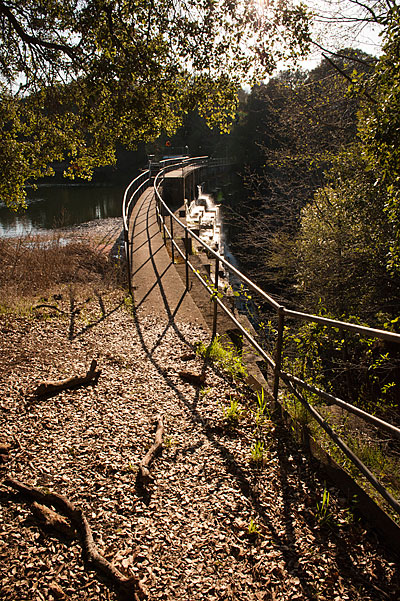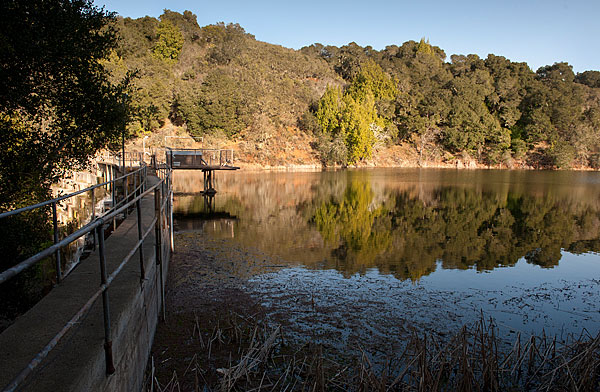Searsville Dam steering committee wrestling with complex issues
The steering committee studying the future of Searsville Dam and Reservoir is preparing to engage consultants, while continuing discussions with local organizations and residents, as it begins sorting through the complicated issues governing the dam's fate.
The Stanford steering committee assessing Searsville Dam and Reservoir plans to begin drawing on the expertise of consultants to help sort through the enormously complex issues involved in deciding the dam's future.
In the next several months, staff members supporting the work of the committee will engage consultants specializing in such areas as engineering and hydrology; ecosystems and biological resources; and land use and environmental planning, according to Jean McCown, co-chair of the steering committee and director of community relations.
The resulting studies will cover some 20 subtopics, including, for example, dam structure and long-term integrity, downstream impacts from changes in sediment, fish passage and archeological resources. Possible changes to be considered as part of the studies range from dredging the reservoir to bypassing the dam to altering or removing it. Also factored into the studies will be the possible effect of such occurrences as droughts, catastrophic storms and earthquakes.
The steering committee's objective is to study the dam and reservoir, located on San Francisquito Creek in the Jasper Ridge Biological Preserve, and make recommendations about their future in light of the needs of the university, the surrounding community and the environment. The committee's work is expected to take approximately two years.
"It has been a challenge to formulate the key questions to be studied so that our deliberations will, in turn, help us balance all the competing priorities," McCown said "It is abundantly clear that there is no one-size-fits-all solution."
The steering committee is co-chaired by Chris Field, professor of biology and of environmental Earth system science and faculty director for the Jasper Ridge Biological Preserve, and McCown. It includes five scholars who specialize in environmental science, history and law, as well as staff members who work in such areas as university land use, sustainability and water resources.
Habitat Conservation Plan
Their long-term study of Searsville Dam and Reservoir was prompted by the university's proposal of a Habitat Conservation Plan (HCP) in 2008. The HCP, which is still under consideration by federal agencies, outlines a comprehensive conservation program for five protected species on Stanford lands and creates permanent easements along 13 miles of San Francisquito, Los Trancos, Matadero and Deer creeks.

Searsville is the only one of Stanford's water storage dams located directly on a stream.
Consideration of Searsville Dam and Reservoir was originally included in the HCP. But the complexity of the environmental issues involved in the dam's future led the university to withdraw the operation and maintenance of the dam and reservoir from the HCP and to create the steering committee.
Searsville – the only one of Stanford's water storage dams located directly on a stream – was built in 1892 by the for-profit Spring Valley Water Company and acquired by the university in 1919. Searsville Lake was once a recreational area, and archival postcards show people riding horseback there.
Today, sedimentation in the reservoir has reduced the water quantity to 10 percent of its original capacity. The dam, which is structurally sound, provides a source of non-potable water used at Stanford for landscape irrigation.
San Francisquito watershed
Since June, McCown said, the steering committee has been reviewing the extensive collection of existing engineering, hydrology and biology studies of not only Searsville Dam, but also the entire San Francisquito Creek watershed area.
The watershed starts in the Santa Cruz Mountains, where many tributaries and creeks combine into San Francisquito Creek and eventually empty into San Francisco Bay. Over thousands of years, the sediment carried in the creeks created the land upon which much of Palo Alto, East Palo Alto, Menlo Park, Atherton and Stanford now sit.
Many of these studies being reviewed by the committee will be posted to a public website to increase communication with the area residents and organizations equally concerned about the dam's future. The website will include downloadable articles and studies on such subjects as dam removal and operations, engineering and hydrology and biology.
Last fall, a workshop for many of those organizations was held at Stanford, and more such gatherings are planned for the future. Among the groups represented were the Crescent Park Neighborhood Association, the Committee for Green Foothills, CalTrout, Santa Clara Audubon, American Rivers, Beyond Searsville Dam, the San Francisquito Creek Joint Powers Authority and the Santa Clara Valley Water District.
McCown said the steering committee has placed a high priority on communicating with area residents and organizations because of the complexity and potential effects of virtually every option to be considered.
Steelhead and native species
Of particular concern to the university and many of the area organizations is the survival of the threatened steelhead. Steelhead are the anadromous form of rainbow trout, meaning they are born in freshwater creeks like San Francisquito, spend most of their lives at sea and return to their freshwater creek of origin to spawn. Since they migrate from February to April, drought winters such as the current one pose challenges to their survival, as does pollution.
Stanford has built fish ladders on several creeks that allow better upstream passage for steelhead, and the HCP proposes to remove structures that might impede their migration.
Also of concern are the effects that changes in Searsville Reservoir could cause in wetlands and other habitats that have been created in the 125 years since the dam was built. Unknown, for instance, is the effect eliminating Searsville Reservoir would have on the insects that support native species thriving at Jasper Ridge Biological Preserve. Many of these species are the focus of university research into climate change and other environmental challenges. Among those the steering committee has heard from are Philippe Cohen, administrative director of Jasper Ridge, and Alan Launer, Stanford conservation program manager.
"What I'm really concerned about is that the wetlands and reservoir represent a substantial portion of the native biodiversity present on the preserve – and not just non-native species," said Cohen. "If we manage our efforts poorly, we could have a deleterious impact on the native biodiversity of the preserve."
Cohen points out that freshwater wetlands have become virtually extinct in Northern California, meaning that the area partly created by Searsville Dam may actually be an irreplaceable biological resource.


Share This Story